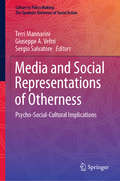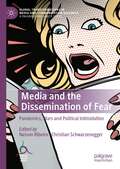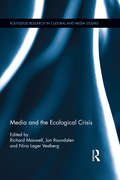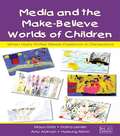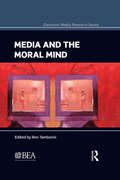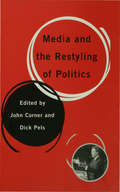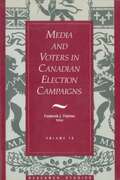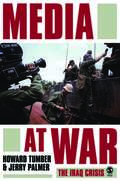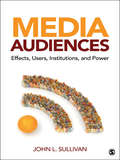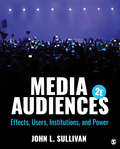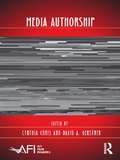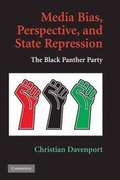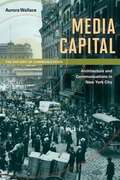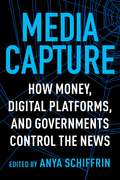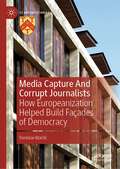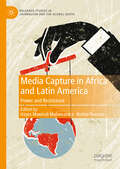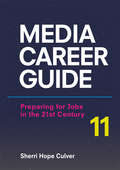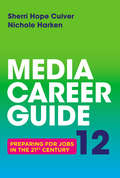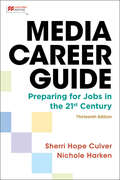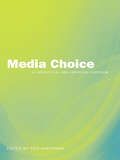- Table View
- List View
Media and Social Representations of Otherness: Psycho-Social-Cultural Implications (Culture in Policy Making: The Symbolic Universes of Social Action)
by Giuseppe A. Veltri Sergio Salvatore Terri MannariniThis book presents the main findings of an empirical exploration of media discourses on social representations of “otherness” in seven European countries. It focuses on the analysis of press discourses produced over a fifteen-year period (2000–2015) on three contemporary figures of otherness that challenge the identity of European societies, question the attitudes towards diversity, and pose significant challenges for policy-makers: immigration, Islam, and LGBT. The book provides a comprehensive and articulate map of how national media addresses such themes from both synchronic and diachronic perspectives, revealing patterns of continuity and discontinuity across time and space. Lastly, it discusses these patterns in the light of their cultural meanings and their influence on social and political collective behaviours.
Media and the Dissemination of Fear: Pandemics, Wars and Political Intimidation (Global Transformations in Media and Communication Research - A Palgrave and IAMCR Series)
by Nelson Ribeiro Christian SchwarzeneggerThis book offers a diachronical and inter-/transmedia approach to the relationship of media and fear in a variety of geographical and cultural settings. This allows for an in-depth understanding of the media’s role in pandemics, wars and other crises, as well as in political intimidation. The book assembles chapters from a variety of authors, focusing on the relation between media and fear in the West, the Middle East, the Arab World and China. Besides its geographical and cultural diversity, the volume also takes a long-term perspective, bringing together cases from transforming media environments which span over a century. The book establishes a strong and historically persistent nexus between media and fear, which finds ever-new forms with new media but always follows similar logics.
Media and the Ecological Crisis (Routledge Research in Cultural and Media Studies)
by Richard Maxwell Jon Raundalen Nina Lager VestbergMedia and the Ecological Crisis is a collaborative work of interdisciplinary writers engaged in mapping, understanding and addressing the complex contribution of media to the current ecological crisis. The book is informed by a fusion of scholarly, practitioner, and activist interests to inform, educate, and advocate for real, environmentally sound changes in design, policy, industrial, and consumer practices. Aligned with an emerging area of scholarship devoted to identifying and analysing the material physical links of media technologies, cultural production, and environment, it contributes to the project of greening media studies by raising awareness of media technology’s concrete environmental effects.
Media and the Make-Believe Worlds of Children: When Harry Potter Meets Pokemon in Disneyland (Routledge Communication Series)
by Maya Gotz Dafna Lemish Hyesung Moon Amy AidmanMedia and the Make-Believe Worlds of Children offers new insights into children's descriptions of their invented or "make-believe" worlds, and the role that the children's experience with media plays in creating these worlds. Based on the results of a cross-cultural study conducted in the United States, Germany, Israel, and South Korea, it offers an innovative look at media's role on children's creative lives.This distinctive volume:*outlines the central debates and research findings in the area of children, fantasy worlds, and the media;*provides a descriptive account of children's make-believe worlds and their wishes for actions they would like to take in these worlds;*highlights the centrality of media in children's make believe worlds;*emphasizes the multiple creative ways in which children use media as resources in their environment to express their own inner worlds; and*suggests the various ways in which the tension between traditional gender portrayals that continue to dominate media texts and children's wishes to act are presented in their fantasies.The work also demonstrates the value of research in unveiling the complicated ways in which media are woven into the fabric of children's everyday lives, examining the creative and sophisticated uses they make of their contents, and highlighting the responsibility that producers of media texts for children have in offering young viewers a wide array of role models and narratives to use in their fantasies. The downloadable resources provide full-color images of the artwork produced during the study.This book will appeal to scholars and graduate students in children and media, early childhood education, and developmental psychology. It can be used in graduate level courses in these areas.
Media and the Moral Mind (Electronic Media Research Series)
by Ron TamboriniQuestions regarding the relation between media and morality have been a lasting concern. Can media exposure shape or alter moral values? Does morality influence how audience members select, interpret and respond to media content? Attempts to answer such questions are hindered by the complex nature of morality and its dynamic relation with media. This volume brings together leading scholars in an effort to examine reciprocal processes that connect media with morality, and to set a course for understanding this association. Individual essays combine established and emerging theories from media and moral psychology to explain how fundamental mechanisms that govern moral reasoning can shape and be shaped by media exposure. Together these scholars provide an understanding of the relationship between media and morality that should serve as an invaluable resource for current and future generations of researchers.
Media and the Portuguese Empire
by José Luís Garcia Chandrika Kaul Filipa Subtil Alexandra SantosThis volume offers a new understanding of the role of the media in the Portuguese Empire, shedding light on the interactions between communications, policy, economics, society, culture, and national identities. Based on an interdisciplinary approach, this book comprises studies in journalism, communication, history, literature, sociology, and anthropology, focusing on such diverse subjects as the expansion of the printing press, the development of newspapers and radio, state propaganda in the metropolitan Portugal and the colonies, censorship, and the uses of media by opposition groups. It encourages an understanding of the articulations and tensions between the different groups that participated, willingly or not, in the establishment, maintenance and overthrow of the Portuguese Empire in Angola, Mozambique, S#65533;o Tom#65533; e Pr#65533;ncipe, Cape Verde, Guinea-Bissau, India, and East Timor.
Media and the Restyling of Politics: Consumerism, Celebrity and Cynicism
by John Corner Dr Dick PelsWithin media research and cultural studies, the mediation of politicians and the play-off between versions of high and low politics are attracting increasing interest. Media and the Restyling of Politics brings together the work of leading academics in media and cultural studies to pursue an agenda of research, analysis and debate about the changing nature of political culture and its mediation. The contributors question the ways in which emerging forms of political style relate not only to new conventions of celebrity and publicity but to ideas about representation, citizenship and the democratic process. Topics covered include: celebrity politicians, the marketing of politics, identity and popular culture.
Media And Voters In Canadian Election Campaigns
by Frederick J. FletcherThis volume presents five studies on the relationship between the media and voters. Each examines some aspects of the flow of information to voters during election campaigns and all reflect the assumption that the right to vote must include the right of access and sufficient information to make an informed decision. In separate studies, Jean Crête and Robert MacDermid examine existing studies and data on the relationship between attention to media and voter information and behaviours. Both studies discuss methods for improving voter information. Televised leaders debates have become an important feature of democratic elections. Cathy Widdis Barr examines the effects of these debates on Canadian voters in 1984 and 1988, concluding that they were an important source of campaign information for less-informed voters. Robert Bernier and Denis Monière provide the most comprehensive comparative overview available on the importance of televised leaders debates and the policy issues surrounding them in democratic countries. Finally, Lyndsay Green examines the potential of new communication technologies for improving the information available to voters during campaigns, with particular attention to voters with special information needs. Taken together, the five studies provide a useful overview of the effectiveness of various forms of campaign communication in informing voters. Much of the material presented here is not readily available elsewhere.
Media Anthropology
by Eric W. Rothenbuhler Dr Mihai ComanMedia Anthropology represents a convergence of issues and interests on anthropological approaches to the study of media. The purpose of this reader is to promote the identity of the field of study; identify its major concepts, methods, and bibliography; comment on the state of the art; and provide examples of current research. Based on original articles by leading scholars from several countries and academic disciplines, Media Anthropology provides essays introducing the issues, reviewing the field, forging new conceptual syntheses.
Media at War: The Iraq Crisis
by Howard Tumber Jerry Palmer′Tumber and Palmer have provided an invaluable review of how journalists covered and reported the Iraq war and its aftermath. Their exhaustive research has resulted in an impressive analysis that makes this book essential reading′ - John Owen, Executive Producer of News Xchange and Visiting Professor of Journalism, City University ′This is a meticulously researched book that lays bare the way the war was reported. Decide for yourself whether the media ′embeds′ - of whom I was one - were the world′s eyes and ears inside the military, or merely the puppets of the Pentagon and the Ministry of Defence in London′ - Ben Brown, BBC ′Media at War offers insights into the ways in which media at war inevitably become participants in both the military and the political wars′ - Professor Michael Gurevitch, University of Maryland International media coverage of the war in Iraq provoked public scrutiny as well debate amongst journalists themselves. Media at War offers a critical overview of the coverage in the context of other preceding wars, including the first Gulf War, and opens up the debate on the key questions that emerged during the crisis. For example, - What did we actually gain from ′live, on the spot′ reporting? - Were journalists adequately trained and protected? - How compromised were the so-called ′embedded′ journalists? Tumber and Palmer′s analysis covers both the pre-war and post war phase, as well as public reaction to these events, and as such provides an invaluable framework for understanding how the media and news organisations operated during the Iraq Crisis.
Media Audiences: Effects, Users, Institutions, and Power
by John L. SullivanDespite the widespread use of the term "audience" in our popular culture, the meaning of "audience" is complex, and it has undergone significant historical shifts over time. Media Audiences explores the concept of media audiences from four broad perspectives, as "victims" of mass media, as market constructions and commodities, as users of media, and as producers and subcultures of mass media.
Media Audiences: Effects, Users, Institutions, and Power
by John L. SullivanWhether we are watching TV, surfing the Internet, listening to our iPods, or reading a novel, we all engage with media as an audience. Despite the widespread use of this term in our popular culture, the meaning of the "audience" is complex, and it has undergone significant historical shifts as new forms of mediated communication have developed from print, telegraphy, and radio to film, television, and the Internet. John L. Sullivan's second edition of Media Audiences: Effects, Users, Institutions, and Power explores the concept of media audiences from four broad perspectives: as "victims" of mass media, as market constructions & commodities, as users of media, and as producers & subcultures of mass media. The goal is for students to be able to think critically about the role and status of media audiences in contemporary society, reflecting on their relative power in relation to institutional media producers.
Media Audiences: Effects, Users, Institutions, and Power
by John L. SullivanWhether we are watching TV, surfing the Internet, listening to our iPods, or reading a novel, we all engage with media as an audience. Despite the widespread use of this term in our popular culture, the meaning of the "audience" is complex, and it has undergone significant historical shifts as new forms of mediated communication have developed from print, telegraphy, and radio to film, television, and the Internet. John L. Sullivan's second edition of Media Audiences: Effects, Users, Institutions, and Power explores the concept of media audiences from four broad perspectives: as "victims" of mass media, as market constructions & commodities, as users of media, and as producers & subcultures of mass media. The goal is for students to be able to think critically about the role and status of media audiences in contemporary society, reflecting on their relative power in relation to institutional media producers.
Media Authorship (AFI Film Readers)
by Cynthia Chris David A. GerstnerContemporary media authorship is frequently collaborative, participatory, non-site specific, or quite simply goes unrecognized. In this volume, media and film scholars explore the theoretical debates around authorship, intention, and identity within the rapidly transforming and globalized culture industry of new media. Defining media broadly, across a range of creative artifacts and production cultures—from visual arts to videogames, from textiles to television—contributors consider authoring practices of artists, designers, do-it-yourselfers, media professionals, scholars, and others. Specifically, they ask: What constitutes "media" and "authorship" in a technologically converged, globally conglomerated, multiplatform environment for the production and distribution of content? What can we learn from cinematic and literary models of authorship—and critiques of those models—with regard to authorship not only in television and recorded music, but also interactive media such as videogames and the Internet? How do we conceive of authorship through practices in which users generate content collaboratively or via appropriation? What institutional prerogatives and legal debates around intellectual property rights, fair use, and copyright bear on concepts of authorship in "new media"? By addressing these issues, Media Authorship demonstrates that the concept of authorship as formulated in literary and film studies is reinvigorated, contested, remade—even, reauthored—by new practices in the digital media environment.
Media Bias, Perspective, and State Repression: The Black Panther Party
by Christian DavenportThis book examines information reported within the media regarding the interaction between the Black Panther Party and government agents in the Bay Area of California (1967-1973). Christian Davenport argues that the geographic locale and political orientation of the newspaper influences how specific details are reported, including who starts and ends the conflict, who the Black Panthers target (government or non-government actors), and which part of the government responds (the police or court). Specifically, proximate and government-oriented sources provide one assessment of events, whereas proximate and dissident-oriented sources have another; both converge on specific aspects of the conflict. The methodological implications of the study are clear; Davenport's findings prove that in order to understand contentious events, it is crucial to understand who collects or distributes the information in order to comprehend who reportedly does what to whom as well as why.
Media Capital: Architecture and Communications in New York City (The History of Communication)
by Aurora WallaceIn a declaration of the ascendance of the American media industry, nineteenth-century press barons in New York City helped to invent the skyscraper, a quintessentially American icon of progress and aspiration. Early newspaper buildings in the country's media capital were designed to communicate both commercial and civic ideals, provide public space and prescribe discourse, and speak to class and mass in equal measure. This book illustrates how the media have continued to use the city as a space in which to inscribe and assert their power. With a unique focus on corporate headquarters as embodiments of the values of the press and as signposts for understanding media culture, Media Capital demonstrates the mutually supporting relationship between the media and urban space. Aurora Wallace considers how architecture contributed to the power of the press, the nature of the reading public, the commercialization of media, and corporate branding in the media industry. Tracing the rise and concentration of the media industry in New York City from the mid-nineteenth century to the present, Wallace analyzes physical and discursive space, as well as labor, technology, and aesthetics, to understand the entwined development of the mass media and late capitalism.
Media Capture: How Money, Digital Platforms, and Governments Control the News
by Edited by Anya SchiffrinWho controls the media today? There are many media systems across the globe that claim to be free yet whose independence has been eroded. As demagogues rise, independent voices have been squeezed out. Corporate-owned media companies that act in the service of power increasingly exercise soft censorship. Tech giants such as Facebook and Google have dramatically changed how people access information, with consequences that are only beginning to be felt.This book features pathbreaking analysis from journalists and academics of the changing nature and peril of media capture—how formerly independent institutions fall under the sway of governments, plutocrats, and corporations. Contributors including Emily Bell, Felix Salmon, Joshua Marshall, Joel Simon, and Nikki Usher analyze diverse cases of media capture worldwide—from the United Kingdom to Turkey to India and beyond—many drawn from firsthand experience. They examine the role played by new media companies and funders, showing how the confluence of the growth of big tech and falling revenues for legacy media has led to new forms of control. Contributions also shed light on how the rise of right-wing populists has catalyzed the crisis of global media. They also chart a way forward, exploring the growing need for a policy response and sustainable models for public-interest investigative journalism. Providing valuable insight into today’s urgent threats to media independence, Media Capture is essential reading for anyone concerned with defending press freedom in the digital age.
Media Capture And Corrupt Journalists: How Europeanization Helped Build Façades of Democracy (St Antony's Series)
by Tomislav MaršićThis book explores the form, dynamics, and main reasons for media capture and conspiracy between editors and executive politicians in Central and Eastern Europe (CEE) since 2000. Situated in the literatures on Europeanization, democratization, party studies, and media studies, the book aims to connect these fields by showing that internal party dynamics play an important role in motivating executive politicians to hijack or collaborate with media. Against this backdrop, the book tells the story of Croatian journalism in the context of media-mafia conglomerates, political corruption, and media hijacking, and examines how "traditional" democratic drivers that the literature frequently cites, such as Europeanization and party competition, failed to prevent systematic transgressions by politicians. Methodologically, the book takes a two-pronged approach. First, nearly 50 interviews were conducted with Croatian investigative journalists, from which the narratives about the relationships between government politicians and editors over 15 years were reconstructed. In a second step, a sample of 40,000 media articles was subjected to a computational sentiment analysis, covering the same 15-year period and showing high levels of cooperation between corrupt politicians and corrupt media outlets.
Media Capture in Africa and Latin America: Power and Resistance (Palgrave Studies in Journalism and the Global South)
by Hayes Mawindi Mabweazara Bethia PearsonHow can current debates on ‘media capture’ be understood within the contexts of Africa and Latin America? This edited collection provides a nuanced exploration of media capture—a critical yet contested concept that examines and illuminates how media can become skewed in favour of power—while also highlighting spaces and strategies of resistance. By adopting a South-South perspective, it brings together scholars focused on these issues in both regions, featuring a dialogue between two leading scholars, Herman Wasserman and Silvio Waisbord in the Foreword. The book not only demonstrates how media practices in Africa and Latin America are influenced by the political economy of their media systems, but also contributes significantly to advancing empirical, theoretical, and comparative research on media in non-Western settings.
Media Career Guide: Preparing for Jobs in the 21st Century
by Sherri Hope CulverIn this economic climate, students need more help than ever navigating the media job marketplace. By providing practical career tips and current statistics, the Media Career Guide is the ideal starting point for a successful communication-related job search. Beginning with an overview of today’s employment environment and opportunities, the manual guides readers through the process of researching, interviewing for, and landing that perfect media job. The new edition now offers career advice from real media professionals and emphasizes the importance of creating and maintaining a professional online presence for the workplace. And, with added information on how to start your own business, students will find this guide to be a useful resource no matter what media career path they choose.
Media Career Guide: Preparing For Jobs In The 21st Century (Twelfth Edition)
by Sherri Hope Culver Nichole HarkenTargeted to today's media-savvy students, the eleventh edition of Media Career Guide includes the latest information on the emerging employment opportunities in mobile media, as well as tips for developing and honing professional networking skills. This essential manual provides an updated, comprehensive directory of media jobs, and walks readers through the entire job-search process, from researching a company to applying for jobs to displaying appropriate behavior in the workplace.
Media Career Guide: Preparing for Jobs in the 21st Century
by Sherri Hope Culver Nichole HarkenWith a focus on getting media-savvy students ready for a career in media, this essential guide offers a current snapshot of job prospects and opportunities in media and communication. The authors take students through the entire process of career planning, from first considering a media-related career, all the way through their arrival in the workplace, while offering helpful and practical advice and strategies along the way. This edition has a new organization that starts at determining the career and then moves into finding the job. A new focus on growth areas in media industries highlight new career paths in streaming media and app development as well as new media positions within more traditional fields. New life skill tips offer suggestions on issues like how to relocate, manage finances, and more. Available as an e-book, the guide can be purchased on its own, or can be accessed as part of the LaunchPad for Media & Culture 13e by Richard Campbell, Christopher R. Martin, Bettina Fabos, and Ron Becker.
Media, Children, and the Family: Social Scientific, Psychodynamic, and Clinical Perspectives (Routledge Communication Series)
by Jennings Bryant Aletha C. Huston Dolf ZillmannThis book brings together a group of scholars to share findings and insights on the effects of media on children and family. Their contributions reflect not only widely divergent political orientations and value systems, but also three distinct domains of inquiry into human motivation and behavior -- social scientific, psychodynamic (or psychoanalytical), and clinical practice. Each of these three domains is privy to important evidence and insights that need to transcend epistemological and methodological boundaries if understanding of the subject is to improve dramatically. In keeping with this notion, the editors asked the authors to go beyond a summary of findings, and lend additional distinction to the book by applying the "binoculars" of their particular perspective and offering suggestions as to the implications of their findings. One of the goals of the conference that resulted in this book was consensus building in the area of media and family. From examining the findings and insights of a diverse group of scholars, it seems that consensus building in several areas is a distinct possibility. Addressing the concerns of educators about the influence of the mass media of communication -- entertainment programs in particular -- on children and the welfare of the nuclear family, this volume projects directions for superior programming, especially for educational television. The influence of sex and violence on children and adults is given much attention, and the development of moral judgment and sexual expectations, among other things, is explored. The critical analysis of media effects includes examination of positive contributions of the media, such as the search for missing children and exemplary educational programs.
Media Choice: A Theoretical and Empirical Overview
by Tilo HartmannThis volume represents the next generation of research in media psychology, bridging selective exposure into a larger framework of choice in media usage. Considering the myriad media options available to use, this work seeks to answer such questions as: What mechanisms guide an individual's exposure to/choice of media? How can researchers model them? The questions why and how people decide to use media offerings are key in current communication scholarship. Research on selective exposure has addressed this area in the past, but the term 'media choice' is used here to represent any implicit/automatic/spontaneous or explicit/deliberate 'decisions' of the users and subsequent behavioral consequences that lead to a contact with a media stimulus.
Media Commercialization and Authoritarian Rule in China
by Daniela StockmannIn most liberal democracies commercialized media is taken for granted, but in many authoritarian regimes the introduction of market forces in the media represents a radical break from the past with uncertain political and social implications. In Media Commercialization and Authoritarian Rule in China, Daniela Stockmann argues that the consequences of media marketization depend on the institutional design of the state. In one-party regimes such as China, market-based media promote regime stability rather than destabilizing authoritarianism or bringing about democracy. By analyzing the Chinese media, Stockmann ties trends of market liberalism in China to other authoritarian regimes in the Middle East, North Africa, sub-Saharan Africa, and the post-Soviet region. Drawing on in-depth interviews with Chinese journalists and propaganda officials as well as more than 2,000 newspaper articles, experiments, and public opinion data sets, this book links censorship among journalists with patterns of media consumption and media's effects on public opinion.
